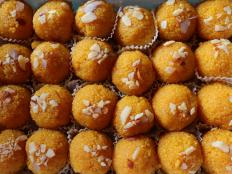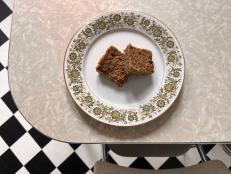Fresh Ube Is Hard To Find in the U.S. – Here’s How You Can Still Cook and Bake With It
Cookbook authors Abi Balingit and Arlyn Osbourne give tips on sourcing and working with the vibrant purple Filipino tuber.

futurewalk/Getty
You might recognize ube, a yam native to Southeast Asia, from its bright purple hue or its resemblance to a sweet potato. Perhaps you’ve tasted it in a classic Filipino dish like halo halo or a more recent innovation like mochi waffles. Or, you’ve seen it all over your feed. Whether you’ve been eating it your whole life, or curious to try it, here’s what you need to know about cooking and baking with this beloved ingredient, especially when you can’t find it fresh.
Ube is used widely in Filipino desserts and baked goods, from chiffon cake to cheese-filled pandesal. It tastes earthy and sweet with notes of vanilla, pistachio and coconut, which works beautifully in all sorts of dishes.
“It’s such an iconic flavor of Filipino food, and it’s so vibrant and purple,” says Abi Balingit, author of Mayumu: Filipino American Desserts Remixed. “It’s a cornerstone of what I believe is really great Filipino food.”
In the past few years, ube has been catching on in the U.S. and venturing beyond its roots. Its eye-catching color made it popular on social media. Today, it's finding a place in mainstream American third-culture cuisine.
“Now, you see ube as a flavor profile for tons of stuff like cheesecake, brownies, banana bread, lattes, doughnuts, Rice Krispie treats. It’s everywhere,” says Arlyn Osborne, author of Sugarcane: Sweet Recipes from My Half-Filipino Kitchen. “I think it kind of came into the spotlight as a trend at first, and it’s really stuck around.”
Since it’s mainly grown in the Philippines, it can be difficult to find fresh here, but don’t be discouraged. There are several ways to get your hands on it, and the dishes you can make with it are endless. Abi has developed recipes for ube-flavored cheesecake bars, lava cakes and a giant crinkle cookie, while Arlyn incorporates it into banana bread, halo halo ice cream and coconut layer cake. We asked them both for tips on sourcing and using ube in its many forms.

jenifoto/Getty
Types of Ube
Frozen
Frozen ube comes pre-cooked, unsweetened and grated or mashed. You can find it in the freezer section of some Asian grocery stores; Abi recommends the brand Pinoy Fiesta. Thaw it overnight and drain before using, then treat it as you would canned pumpkin or mashed sweet potato.
“You can pretty much substitute frozen ube one to one for any recipe that calls for sweet potato puree or pumpkin puree. It’s very similar in texture,” says Arlyn.
She adds that frozen ube bakes well, but it’s dense. If you’re substituting it for another ingredient, then you may need to adjust rising times for breads or bake your cakes for longer than the recipe calls for. You may also need to adjust your level of liquid to balance out the extra weight.
Powder
Powdered ube has a subtle flavor and is shelf-stable, making it easy to keep on hand in your pantry. However, it takes a little more time and work to use than frozen ube. It’s a dehydrated form that needs to be cooked on the stovetop with water to form a paste before using in a recipe. You’ll also need to allow extra time for it to cool before you work with it.
“This is actually my least favorite version because it’s the most fussy,” Arlyn says.
However, she’s recently found another type of ube powder that you could think of as the instant version.
“Lately, I’ve seen some ube powders that [don’t] need to be reconstituted, you can just stir it right into your liquids, your batters or frosting. This is not like the one that I grew up with,” she says. “It’s actually great. You can use it just like you would cocoa powder or dehydrated fruit powders.”
Extract
Ube extract is a liquid flavoring that you can add to dishes, just like any other extract. It provides a lighter flavor and color than frozen or powdered ube, which works particularly well in baked goods or dishes where you want an airy consistency.
Arlyn says you can think of extract as a shortcut option, since it's so quick and effortless; or as a booster option, since you can combine it with another kind of ube.
“You can use it alone, but it’s also a great add-on for recipes that already incorporate ube in another form because it really accentuates the flavor of ube and deepens the color,” she says.
Halaya
Ube halaya is a jam made with condensed and coconut milks. It can be eaten as a dessert on its own, spread as a condiment or mixed into other dishes as a flavoring agent. It has a pronounced ube flavor and is already sweetened, so if you're using it in a recipe that calls for another form of ube, make sure to adjust the sugar. Also note that its sticky, thick consistency can weigh down baked goods the way frozen ube does.
You can buy ube halaya premade at a grocery store. Abi recommends the brand Tropics, and Arlyn adds that Kapuso is also easy to find. Note that Tropics’ ube halaya includes buttermilk while Kapuso’s does not, which may alter the texture of dishes.
“I cross-tested the ube recipes in my cookbook with various brands and there are places where the consistency comes into play,” Arlyn says. “One is the filling of the ube pandesal. Kapuso turned out creamy and gooey, while Tropics came almost custardy. Slight difference. Both delicious.”
Or, you can make ube halaya yourself, as Abi usually does. She developed three versions of ube halaya each using a different base: frozen, powder and Ube Pillows, which are ube-filled snack crackers. The latter is a riff on speculoos cookie butter rather than a typical halaya.
Abi finds the frozen method the fastest and easiest, while the powder is a good alternative for someone who has more time.
“The frozen variation, that was the one I grew up using the most,” Abi says. “My parents, I would always see them making halaya with that.”

Candice Bell/Getty
Tips for Cooking and Baking with Ube
Shop based on what’s available to you, and what your dish and time constraints may be. If you’re short on time, skip ube powder. If you want a strong flavor in your dish, opt for frozen ube or halaya. If you’re trying to make a fluffy cake, reach for extract. And, if you need help sourcing ingredients, Arlyn recommends the online Filipino grocery store SarapNow.
In addition, while ube adds bold color to a dish, remember that it has a delicate flavor. For example, Abi says cinnamon and chocolate can taste delicious with ube, but they can also overpower it.
“I feel like sometimes the nuances of ube as a flavor get lost when paired with very, very strong other flavors,” she says.
Finally, if you’re interested in trying ube in savory dishes, hamburger buns are a fun place to start.
“I’ve definitely seen restaurants do that. It’s a great way to incorporate the sweetness and the earthiness of that flavor ... to contrast with the savoriness of a meat slider,” Abi says.
So, if you’re eager to cook with ube, there are lots of sourcing options available — and limitless culinary possibilities.
Related Content:
































































